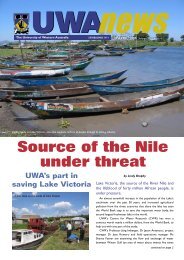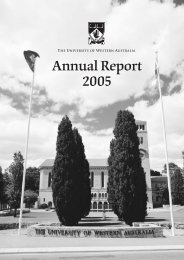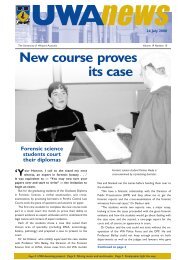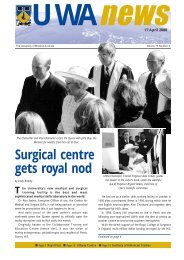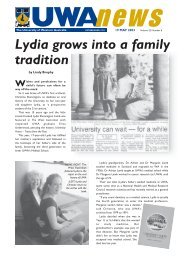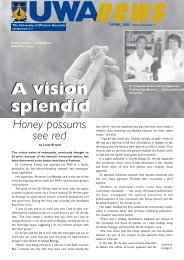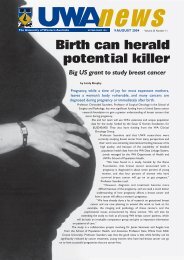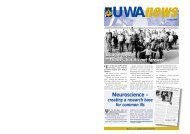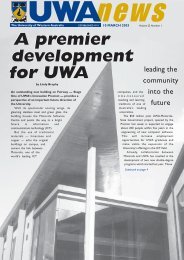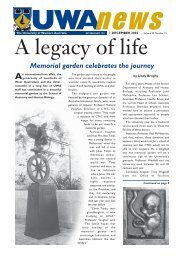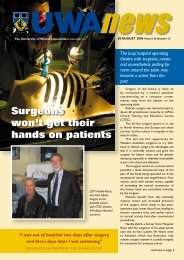22 Aug: Vol 24, #12 - UWA News staff magazine - The University of ...
22 Aug: Vol 24, #12 - UWA News staff magazine - The University of ...
22 Aug: Vol 24, #12 - UWA News staff magazine - The University of ...
- No tags were found...
You also want an ePaper? Increase the reach of your titles
YUMPU automatically turns print PDFs into web optimized ePapers that Google loves.
<strong>UWA</strong> 1911newsEstablished<strong>UWA</strong><strong>The</strong> <strong>University</strong> <strong>of</strong> Western Australia<strong>22</strong>AUGUST 2005 <strong>Vol</strong>ume <strong>24</strong> Number 12
<strong>UWA</strong>newsA cathedral<strong>The</strong> Gravity Discovery Centre has won itsfounders, <strong>UWA</strong>’s David Blair and Curtin<strong>University</strong>’s John de Laeter, the $10,000Australian Government Eureka Prize forpromoting the understanding <strong>of</strong> science.<strong>The</strong> science centre dedicated to the big questions <strong>of</strong> theuniverse was first conceived as a visitor centre for the AustralianInternational Gravitational Observatory near Gingin.“We are searching for gravity waves predicted by Einstein butnever seen,” said physicist Pr<strong>of</strong>essor David Blair, Head <strong>of</strong> theGravity Wave Research Group.“<strong>The</strong> new information this discovery could give us about ouruniverse is staggering. We knew we had to share the excitement<strong>of</strong> our search with the public.”Emeritus Pr<strong>of</strong>essor John de Laeter from Curtin <strong>University</strong> <strong>of</strong>Technology worked with Pr<strong>of</strong>essor Blair to create the Centre.His experience in bringing science to the public through hisinvolvement with the founding <strong>of</strong> Scitech made him the idealperson to chair the Gravity Discovery Centre Foundation.Working in their spare time with a team <strong>of</strong> volunteers, theyhave raised more than $5 million. Among the many attractions atthe growing centre are the largest publicly accessible telescope inthe southern hemisphere and a collaborative telescope that letsstudents study the night sky in other countries.Since the Centre opened in 2003, students have measured theEarth’s rotation with a Foucault Pendulum; taken a one kilometrescale walk to the edge <strong>of</strong> the Solar System; and studied howobjects move as they fall into a giant Black Hole.<strong>The</strong>y can listen to themselves in the past using the Time Coil;hear the song <strong>of</strong> the wind on an Aeolian harp resonating througha giant interferometer pipe; learn about Australian technologyinnovations; and cook their lunches on solar barbeques.Pr<strong>of</strong>essor Blair calls it a cathedral to the heartbeat <strong>of</strong> space.Pr<strong>of</strong>essor David Blair (below) and Pr<strong>of</strong>essor John de Laeter (above) atthe opening <strong>of</strong> the Gravity Discovery Centre nearly two years agoto theheartbeat<strong>of</strong> spaceFrank Howarth, Director <strong>of</strong> the Australian Museum, whichawards the Eureka Prize said: “Every culture has asked questionsabout Life and the Universe. Pr<strong>of</strong>essor Blair and Pr<strong>of</strong>essorde Laeter are giving the next generation <strong>of</strong> explorers theopportunity to discover the answers in unique ways. <strong>The</strong>y areworthy winners <strong>of</strong> the $10,000 Australian Government EurekaPrize for promoting understanding <strong>of</strong> science.”<strong>The</strong> prize is awarded to individuals or groups for outstandingworks <strong>of</strong> science communication and outreach that promoteinterest and enthusiasm about science in the general communityand enhance the public’s ability to assimilate information onscientific issues in an informed and accurate manner, or increasethe community’s understanding <strong>of</strong> the value <strong>of</strong> continuing withscience studies in senior secondary school and beyond.<strong>The</strong> award is sponsored by the Commonwealth Minister forEducation, Science and Training.EDITOR/WRITER<strong>UWA</strong>news Lindy BrophyTel: 6488 <strong>24</strong>36 Fax: 6488 1192 Email: lindy.brophy@uwa.edu.auEDITOR-IN-CHIEFColin Campbell-Fraser Tel: 6488 2889 Fax: 6488 1020Designed, typeset and printed by UniPrint, <strong>UWA</strong>Please note our new web address<strong>UWA</strong>news online: http://uwanews.publishing.uwa.edu.au/THE UNIVERSITY OF WESTERN AUSTRALIA • <strong>22</strong> AUGUST 2005
Vice-Chancellor’scolumnTrackingprogress on theAcademic Pr<strong>of</strong>ileOur Academic Pr<strong>of</strong>ile wasdeveloped in 2000 as an integralpart <strong>of</strong> the <strong>University</strong>’s planningprocess.It was designed to provide the academicbasis for developing (and directingresources preferentially towards) areas<strong>of</strong> particular strength, importance andopportunity over a 10 year period.It set out a strategy for combininga greater emphasis on the selectivedevelopment and resourcing <strong>of</strong> particularactivities within the <strong>University</strong>, withinthe overall context <strong>of</strong> a comprehensiveteaching and research mission.This week, I provided to Senate amid-term (2005) assessment <strong>of</strong> progresstowards achieving the Academic Pr<strong>of</strong>ilewhich particularly highlighted two keyareas.<strong>The</strong> first relates to enrolment targets.Our Academic Pr<strong>of</strong>ile set an enrolmentgrowth target <strong>of</strong> between 20-25 per centover 10 years – with targets (by 2010) <strong>of</strong>a total enrolment <strong>of</strong> around 20,000; anundergraduate : postgraduate mix <strong>of</strong> 70:30;and within the 30 percent <strong>of</strong> postgraduates,a mix <strong>of</strong> 18 per cent research and 12 percent coursework. This year, we have atotal enrolment <strong>of</strong> 16,987, with 76.6 percent undergraduate, 10.4 per cent higherdegree by research, and 13.0 per centpostgraduate coursework.Set against a growth rate <strong>of</strong> 12 percentsince 2001, we can conclude that ourgrowth target <strong>of</strong> 20,000 by 2010 will bemet. However, while we are likely to farexceed the 12 per cent higher degree bycoursework target, unless we continue toact to ensure we increase higher degree byresearch enrolments, we will not achieveour higher degree by research target.We have already intervened to increasethe number <strong>of</strong> higher degree by researchenrolments as a result <strong>of</strong> a review <strong>of</strong>post-graduate research. Initiatives includeincreasing the number <strong>of</strong> <strong>University</strong> fundedscholarships, establishing a fund to meetthe cost <strong>of</strong> fees <strong>of</strong> a number <strong>of</strong> internationalresearch students and increase in teachinginternships. However, it is likely that theimpact <strong>of</strong> these changes will take some timeto become apparent.<strong>The</strong> second issue <strong>of</strong> importance relatesto the areas <strong>of</strong> ‘strategic opportunity’ whichwere identified in the 2000 Academic Pr<strong>of</strong>ileas: exploration, production and exploitation<strong>of</strong> minerals, oil and gas; management<strong>of</strong> agricultural and natural ecosystems;genetic epidemiology; humanities and socialscience research program; health andbiomedicine, injury research, prevention,repair and rehabilitation; Indigenous studies;information technology, telecommunicationsand computer science; and internationalmanagement and business studies.We have found that many <strong>of</strong> these areashave advanced as a result <strong>of</strong> significantexternal funding, and the clustering <strong>of</strong>research into areas <strong>of</strong> strategic opportunityis by key <strong>staff</strong>ing appointments.However, we have also learned that ithas been difficult to advance many <strong>of</strong> theseareas <strong>of</strong> strategic opportunity in the absence<strong>of</strong> general discretionary funding.We also know that although most <strong>of</strong> ourresearch and training centres fit within theeight strategic areas, relationships betweenexisting centres are not sufficiently strongto gain advantage by related centres forminga research cluster within the eight areas.In this context, formation <strong>of</strong> ‘whole<strong>of</strong> institution institutes’ within which thecentres would work to assist in buildingresearch critical mass. Such a model hasbeen demonstrated to work successfully ina number <strong>of</strong> high-performing research-leduniversities in other parts <strong>of</strong> the world andI believe it is a structure which we shouldconsider at our <strong>University</strong>.Alan Robson<strong>UWA</strong>newsVice-ChancellorSmall school<strong>The</strong> smallest school in the<strong>University</strong>, Agricultural andResource Economics (ARE),ranks third in terms <strong>of</strong>research.<strong>The</strong> Dean <strong>of</strong> the Faculty <strong>of</strong> Natural andAgricultural Sciences, Pr<strong>of</strong>essor AlistarRobertson, described the school as “thejewel in the crown” <strong>of</strong> the faculty.“To be ranked third out <strong>of</strong> 33 schoolsis a tremendous achievement and nextyear’s Honours projects in this schoolreflect the breadth <strong>of</strong> the new faculty.<strong>The</strong>y are not just agricultural projects: theschool also includes resource economics,and there is a great diversity <strong>of</strong> research,”he said.Pr<strong>of</strong>essor Robertson was speaking at acelebration <strong>of</strong> an unprecedented amount<strong>of</strong> funding secured by Honours studentsfor their projects next year.Seven <strong>of</strong> the nine Honours studentshave external funding and the othertwo have support in kind from industrypartners.Head <strong>of</strong> School, Associate Pr<strong>of</strong>essorMichael Burton, said the school usuallyhad one or two Honours studentson scholarships, but this year wasoutstanding, with the students bringing inmore than $16,000.“It’s great, not just for the financialside, but for the contacts with thepr<strong>of</strong>ession that are being made by thestudents and the school,” he said.Pr<strong>of</strong>essor Robertson said it wasparticularly important that the studentshad gone out and negotiated their ownfunding because this was what “life afteruniversity would be like.”<strong>The</strong> Honours projects range froman evaluation <strong>of</strong> BankWest’s databaseon farm businesses in WA to a wastetransportation model for BHP Billiton’sactivities in the Pilbara.Matt Titmanis has $5,900 funding fromBankWest to use their extensive databaseto investigate what useful information itcontains, specifically the determinants <strong>of</strong>pr<strong>of</strong>itability, variability in pr<strong>of</strong>itability, andfarm efficiency. His supervisor is Dr BenWhite.Lyon McLeod has sponsorship in kindfrom BHP Billiton to look at its wasteTHE UNIVERSITY OF WESTERN AUSTRALIA • <strong>22</strong> AUGUST 2005
hasbigtransportation methods. Wastes fromseveral mine sites in the Pilbara aretransported over distances <strong>of</strong> up to 500kilometres.“I’m also interested in company policyrelated to the management <strong>of</strong> wastesand the costs these policies incur onsuch companies,” said Lyon, who is alsosupervised by Dr White.Rob Kelly is looking at biologicalwool harvesting: its impact on economicsustainability and adoption in theGreat Southern. He is funded by aGreat Southern Agricultural ResearchScholarship for $2,000.“A decreasing number <strong>of</strong> shearersmeans biological wool harvesting, wherethe sheep are injected with a hormonewhich causes their wool to fall <strong>of</strong>f, isbecoming a viable option,” Rob said. “Myproject will help farmers to understandthis alternative.”Another project based in the GreatSouthern is Kate Shearer’s research into<strong>UWA</strong>newsideasthe value <strong>of</strong> biodiversity and recreationat inland lakes: a case study <strong>of</strong> LakeTowerrinning, also known as Moodiarrup.Kate won the Jennifer ArnoldMemorial Research Grant ($1,168),awarded for projects that encourage amore perfect understanding <strong>of</strong> the naturalenvironment and <strong>of</strong> its value.She hopes to find the social value <strong>of</strong>recreation and biodiversity and how thecommunity views the potential conflict inuse and that this information will be usefulin the management <strong>of</strong> Lake Towerrinning.Kate and Rob are both supervised by DrJo Pluske.Abbie McCartney, Melissa Lamb andJeremy Roberson all have funding fromthe Department <strong>of</strong> Conservation andLand Management (CALM) for theirprojects: Abbie’s is an assessment <strong>of</strong> thesocial value <strong>of</strong> the major seascapes in theJurien Bay marine park.“CALM’s interest is in distinguishingwhich seascapes within the park are <strong>of</strong>most importance to local and touristcommunities, so that conservation effortscan be directed efficiently,” Abbie said.Melissa is investigating the applicability<strong>of</strong> a permit system for the Broke Inlet inthe Warren Region. She and Abbie areboth supervised by A/Pr<strong>of</strong>essor Burton.Jeremy’s project is a model surveydesigned by find out the current humanusage <strong>of</strong> the proposed Gnangara Park, thepreferred land use for the area and thefuture usage <strong>of</strong> the zone. He has $800 forthe project, Abbie has $1,000, and Melissahas $1,500.Ellen Walker won a CRC WeedsScholarship for $4,000 to determine iffarmers find information provided bytheir peers, through participative farmergroup research, more valuable than othersources <strong>of</strong> information. Her supervisor isDr Rick Llewellyn.Jacqueline Giblett has in-kind supportfrom the Department <strong>of</strong> Agriculture WAto evaluate the potential <strong>of</strong> the WA dairyindustry to export heifers to China. Sheis supervised by Dr Greg Hertzler andis also working with Brad Plunkett fromDAWA and Dr Ross Kingwell (DAWAand <strong>UWA</strong>).Honours students share their project ideas:(STANDING) Melissa Lamb, Rob Kelly, EllenWalker, Abbie McCartney, Kate Shearer(SITTING) Matt Titmanis, Jeremy Roberson,Lyon McLeodTHE UNIVERSITY OF WESTERN AUSTRALIA • <strong>22</strong> AUGUST 2005
<strong>UWA</strong>newsGermination discoverya big dealHutch Ranck and Pr<strong>of</strong>essor Alan Robson sign the agreementF a r m e r s a l l o v e r t h eworld should be able,within a decade, to use aseed germination processdiscovered at <strong>UWA</strong> and KingsPark.In a deal described as one <strong>of</strong> themost exciting commercialisationagreements with which the <strong>University</strong>has been involved, international chemicalcompany DuPont has signed a researchdevelopment licence to evaluate andexplore the seed germination technology.Hutch Ranck, Managing Director <strong>of</strong>DuPont Australian and New Zealand, saidhis company could spend up to $US 200million on the project.And Australia’s only Nobel Prizewinningchemist has also taken an interestin the work.Researchers in different parts <strong>of</strong> theworld had been trying for 15 years toisolate the chemical compound in smokethat could germinate seeds. Years <strong>of</strong>hard work by Adjunct Pr<strong>of</strong>essor KingsleyDixon (Kings Park and Plant Biology),Pr<strong>of</strong>essor Emil Ghisalberti (Chemistry)supervising PhD student Gavin Flematti,and Pr<strong>of</strong>essor Robert Trengove (sincemoved to Murdoch <strong>University</strong>) hit thejackpot and, in 2003, the team applied fora patent.<strong>The</strong>ir ground-breaking research waspublished in Science in June 2004.Dr Andy Sierakowski, Director <strong>of</strong> theOffice <strong>of</strong> Innovation and Industry, whohas a background as an organic chemist,admitted that the smoke deal had been apet project for him.“Simon Handford, in OII, has done aremarkable amount <strong>of</strong> work negotiatingthe deal between the researchers andDuPont and thanks must go to him forkeeping me on track,” Dr Sierakowskisaid. “I must have driven Simon crazy, butI was just so excited by the prospects,which are now coming to fruition.”Dr Sierakowski completed apostdoctoral research project in organicchemistry with Nobel Prize winnerJohn Cornforth, and he contacted hisformer supervisor, knowing he would beinterested in the research.“John is also excited about this discoveryand subsequent commercialisation bid, andhe has come up with a couple <strong>of</strong> ideas onwhich some Honours students are nowworking,” he said.Dr Sierakowski said DuPont had beenchosen because the universities needed apartner who had a recognised researchand development capability, access tothe agri-chemical production world, anda seed technology company. It was alsoimportant that DuPont had a good record<strong>of</strong> working with Australian universities.“I had worked in my own agri-chemicalcompany as an organic chemist and Iknew the players in the field, which alsohelped,” he said.At the signing <strong>of</strong> the deal, Pro Vice-Chancellor Pr<strong>of</strong>essor DougMcEachern said having a brightidea, working it through andgetting the science right wasnot the end <strong>of</strong> a project.“We recognise that we, asa university, don’t have theexpertise and capabilities t<strong>of</strong>ollow through this bright idea,and we thank DuPont for taking up thechallenge.”Mr Ranck said the chemical andanalytical skills and the botanic andbiological knowledge <strong>of</strong> the researcherswere world class.“Today is the first step on a journey<strong>of</strong> bio-prospecting. At the end <strong>of</strong> it, wewill be able to replicate one <strong>of</strong> nature’sphenomena and the prospects <strong>of</strong> usingthis compound are truly exciting. But thejourney will take at least five to sevenyears.”As reported in <strong>UWA</strong>news on July 25this year, the compound has the potentialto be used to control weed germinationthat could save Australian farmers billions<strong>of</strong> dollars a year. It could be used togerminate native species without the use<strong>of</strong> fire, thereby saving native fauna. And itcould help with swift restoration <strong>of</strong> minesites by germinating seeds in the topsoil.Dr Andy Sierakowski …a pet projectTHE UNIVERSITY OF WESTERN AUSTRALIA • <strong>22</strong> AUGUST 2005
<strong>UWA</strong>newsIn the 1980s young Australian women wereenjoying the fruits <strong>of</strong> the feminism battle, workingalongside men in every area <strong>of</strong> endeavour —except, it seems, geology.In that decade, it was still not acceptable for women to work on<strong>of</strong>fshore drilling rigs. <strong>The</strong> story <strong>of</strong> how that changed was the winningentry in the Share Your History competition, run by <strong>UWA</strong>’s Centre forWestern Australian History.When the Centre launched its Historical Encyclopedia <strong>of</strong> WesternAustralia project, community response was so enthusiastic thatthe centre ran a Share Your History promotion to encourage localcontributions, the best <strong>of</strong> which would be posted on the encyclopediawebsite.<strong>The</strong> response was a deluge <strong>of</strong> entries, “and some <strong>of</strong> them were sogood that we decided to have an adult and junior prize for the bestones,” editor-in-chief Associate Pr<strong>of</strong>essor Jenny Gregory said.<strong>The</strong> winning junior entry came from Imogen Forbes-Macphail,and the adult winner was <strong>UWA</strong> research fellow Marjorie Apthorpe,whose contribution revealed that it was not until the 1980s thatwomen geologists were accepted as co-workers on <strong>of</strong>fshorepetroleum drilling rigs in Australia.<strong>The</strong> breakthrough for Ms Apthorpe came only because <strong>of</strong> atechnical problem at a Woodside Petroleum <strong>of</strong>fshore site. Drillinghad not reached the expected target at the expected depth, andthe company needed speedy answers to pressing questions, so MsApthorpe and production geologist Judy Garstone were flown byhelicopter to the drill ship.<strong>The</strong>ir arrival created “something <strong>of</strong> a stir,” recalls Ms Apthorpe(pictured right on the rig). “Not all the crew were happy about thisradical new <strong>staff</strong> development; we were told that at least one drillerhad to rummage for shorts to cover his normal <strong>of</strong>f-duty garb <strong>of</strong>underpants.”<strong>The</strong> two women set to work, and after midnight on day two MsApthorpe confirmed that the rock samples she was examining werewithin 30 metres <strong>of</strong> the top <strong>of</strong> the gas reservoir. Within minutes thedrill bit was cutting into the top <strong>of</strong> the reservoir and the gas pressurewas showing up on the instrument monitors. “We had finally reachedthe sandstone reservoir, and it contained gas! Collective relief spreadrapidly through the entire crew.”Women quickly became accepted on the team <strong>of</strong> geologists,reservoir engineers, paleontologists (usually palynologists) and otherswho now regularly work on <strong>of</strong>fshore rigs. “Young women entering thepetroleum industry today are <strong>of</strong>ten totally unaware <strong>of</strong> how recentlythis acceptance <strong>of</strong> women occurred.”You can see the winning contributions, plus a selection <strong>of</strong> the bestentries on the HEWA website: www.encyclopedia.uwapress.uwa.edu.au.Although the stories generated by the promotion will not be includedin the encyclopedia, a selection <strong>of</strong> commissioned entries intended forpublication can be seen on the WA Snapshots page <strong>of</strong> the website.As expected, compiling an encyclopedia is a huge undertaking. “Wehave commissioned 837 entries and received 748, so things are goingwell - though <strong>of</strong> course every entry has to go on to an expert readeror reviewer,” editor Dr Jan Gothard said. “We have 479 writersworking for us, and 152 expert readers involved.”<strong>The</strong> entries are compiled according to a number <strong>of</strong> selectedthemes such as Aboriginal history, sport and recreation, agricultureand so on. If all goes according to plan, the encyclopedia will belaunched in 2006.Womenon rigsa very short historyTHE UNIVERSITY OF WESTERN AUSTRALIA • <strong>22</strong> AUGUST 2005
<strong>UWA</strong>newsGreen star for Business School‘Green Star’building for Business Schoolby Maureen de la HarpeA spectacular new building is due to take shape nextyear at the south-eastern corner <strong>of</strong> the campus.<strong>The</strong> Business School will invest the southern end with a newcontemporary identity, in the same way that Winthrop Hall reflects theuniversity’s classical heritage at the northern end.It will also be <strong>UWA</strong>’s first Green Star-rated building, possibly even thefirst in WA, according to project and systems coordinator Patrick Whelan,<strong>UWA</strong>’s representative on this project. This national rating has been devisedby the Green Building Council <strong>of</strong> Australia, and although the Council doesnot yet formally rate educational institutions, based on their guidelines, thebuilding will meet the requirements for top Green Star rating.Ross Donaldson, director <strong>of</strong> architects Woods Bagot, said that althoughglass would be a feature <strong>of</strong> the building, taking advantage <strong>of</strong> views to theriver, the east-west axis meant the summer sun would not strike theglass. “And instead <strong>of</strong> normal air conditioning, there will be chilled beamtechnology, so the energy consumed is low.”He describes the design as “quite unconventional in the WAsocial spaces and learning environments. It will feel somewhat dthe buildings on the campus.”It also reflects the future direction <strong>of</strong> tertiary educationwhose company has worked with educational institutions arglobal trend is towards a social mode <strong>of</strong> learning that calls foraccommodate groups in lounges and cafes, and allow for wireleas seminar rooms and lecture theatres.<strong>The</strong> State’s landscape and economy are reflected in the descolours, and patterns in copper, zinc, aluminium and stainless stwill not carry through the terracotta ro<strong>of</strong> theme, terracottawalls, along with limestone hues.<strong>The</strong> spectacular wing (pictured above) jutting out at a dramlecture theatre, which will have raked seating. A side wall featby photographs <strong>of</strong> Western Australian landscapes.Ross Donaldson sees the project signaling a new era for thehis own degree at <strong>UWA</strong> and is enjoying “being able to give salma mater.”THE UNIVERSITY OF WESTERN AUSTRALIA • <strong>22</strong> AUGUST 2005
<strong>UWA</strong>newsDragon brings leaders togethercontext, focusing onifferent from most <strong>of</strong>, said Mr Donaldson,ound the world. <strong>The</strong>a variety <strong>of</strong> spaces toss networking, as wellign through materials,eel. While the buildingtiles will be used onatic angle is the mainures a design inspireduniversity. He gainedomething back to my<strong>UWA</strong> Business School lecturer Dr Fang Liu (pictured on an earlier trip to China,above left) is in Hong Kong this week as one <strong>of</strong> 100 delegates selected toattend the Dragon 100 Young Chinese Leaders Forum.Dragon 100 is sponsored by the Hong Kong-based Dragon Foundation, set up in 2000 to create anetwork <strong>of</strong> young Chinese future leaders. Each year the foundation brings together 100 talented under-35sfrom around the world for a forum and study tour. <strong>The</strong> aim: to provide a platform for them to exchangeideas on global issues and contribute to their communities while at the same time promoting Chineseculture and heritage.<strong>The</strong> theme <strong>of</strong> the 2005 program, which runs from <strong>Aug</strong>ust 21-29, is ‘Opportunities in China: A Vision fora Shared Future’. It involves a three-day forum followed by a five-day study tour in Shanghai.“I feel very proud and privileged to be selected by the Dragon Foundation to attend this internationalevent. I understand this is the first time that <strong>UWA</strong> has nominated someone to attend this highlycompetitive event,” says Ms Liu, who lectures in marketing. “I would like to thank everyone at <strong>UWA</strong> whomade it possible.”On the study tour she expects to meet government <strong>of</strong>ficials and young pr<strong>of</strong>essionals heading up varioussectors, and to visit local universities. “I want to see how China is developing and how overseas Chinesecan contribute. As Shanghai is the most developed city, there are a lot <strong>of</strong> things going on. I would like tosee the achievements, but probably also to discuss some <strong>of</strong> the social problems that have arisen from thisfast growth – such as the disparity between the rich and poor – and what is being done to solve them. <strong>The</strong>foundation wants us to see both sides and to contribute.”Although she visits China regularly to carry out research and attend conferences, Dr Liu has notpreviously had the opportunities that Dragon 100 will <strong>of</strong>fer. “I think I have never had a really good chanceto meet and share ideas with people from different areas and diverse backgrounds such as industry,education and regional development. Being with 99 other delegates from different countries will be a goodopportunity to see what they are thinking and what I can learn from them.”Dr Liu was born and educated in China, where she gained a BA in linguistics and literature at Zhongshan<strong>University</strong>, which she describes as one <strong>of</strong> the most prestigious in China. She garnered numerous academicawards during her studies, and founded a Spoken English Club and an English campus newspaper Pilgrimage(“maybe the first <strong>of</strong> such at universities in China”). A member <strong>of</strong> the Zhongshan debating team, she alsochaired the Student Union at the School <strong>of</strong> Foreign Languages. Prior to leaving China, she worked ininternational trade and management with large state-owned enterprises.While studying for her MBA and PhD in marketing at <strong>UWA</strong>, where she has been lecturing since 1999,she chaired the Chinese Scholars and Students Association for two years; she was a founding member <strong>of</strong>the Western Australian Chinese Scientific Association and is now treasurer.THE UNIVERSITY OF WESTERN AUSTRALIA • <strong>22</strong> AUGUST 2005
10 <strong>UWA</strong>newsWorking together creates supportA simple solution to a problem in a <strong>University</strong>library has been an excellent example <strong>of</strong> <strong>staff</strong>from different areas working together.<strong>The</strong> Education, Fine Arts and Architecture (EDFAA) Libraryhas hundreds <strong>of</strong> big heavy art and architecture books that usedto fall over when somebody took a nearby book <strong>of</strong>f the shelf.Straightening the shelves was becoming a problem and causingphysical pain to library <strong>staff</strong>.<strong>The</strong> problem was identified by EDFAA library <strong>staff</strong> CaroleDuffil and Judy Smith; they asked advice from Safety andHealth Office (SHO) occupational therapist Averil Riley, whodid some research and came up with an idea; <strong>staff</strong> at FacilitiesManagement, particularly tradesman, welding expert and sculptorOne <strong>of</strong> the world’s great artshows will feature a sculptureby <strong>UWA</strong> <strong>staff</strong> member LenZuks.Len’s steel sculpture <strong>of</strong> a horse andrider has been chosen to be part <strong>of</strong> theBeijing Biennale, China’s biggest and mostimportant art exhibition, opening nextmonth.He has been an artist and sculptor allhis life but says he also enjoys his work asa tradesman for the Facilities Management(FM) maintenance workshop.“It’s hard to make a living as an artist,but I don’t do it for the money, I do itbecause I love it,” he said.Len was at the exhibition <strong>of</strong> Sculpturesby the Sea at Cottesloe early this year atthe same time as a Chinese delegation.“<strong>The</strong>y were talking about acquiring artfor the Beijing Olympics, so they couldline the road between the airport andthe Olympic Village with installations. Ihappened to have photographs <strong>of</strong> someLen Zuksexplains hisdesign tolibrarian JudySmithAn Aussie icon in China<strong>of</strong> my work with me and showed themto them. <strong>The</strong>y immediately chose one<strong>of</strong> my pieces, then returned to Beijingwhere a committee decided on a differentpiece, then asked me to exhibit it in theBiennale,” he said.“It was one <strong>of</strong> those hugely luckycircumstances.”Len’s horse and rider sculpture is 1.8metres tall, 1.8 metres long and about ametre wide. He calls it Duffer McCreedyafter a fictitious iconic Australian outbackcharacter.“He was a hard-working but illiteratestation hand, who met a teacher whocame to the station, learnt to read andwrite, fell in love with the teacher andmarried her, but didn’t quite overcomesome <strong>of</strong> his early ways.“<strong>The</strong> police were after him for somepetty thieving, so he ran away to war,served in Gallipoli and returned hometo make a lot <strong>of</strong> money on the land, thenbecame a philanthropist.“It’s the story <strong>of</strong> our land <strong>of</strong>THE UNIVERSITY OF WESTERN AUSTRALIA • <strong>22</strong> AUGUST 2005Len Zuks (see also below), played around with the idea and, aftera few prototypes, and the help <strong>of</strong> Peter Norgard in the electricalengineering workshop, came up with the solution; and Libraryadministration manager Annie Macnab initiated the project andfound funding for it.Judy Smith explained that while most library books weighedabout 500 grams, EDFAA’s big books could weigh up to fourkilograms. <strong>The</strong> <strong>staff</strong> were getting repetitive use strain fromcontinually sorting the books, which were held up only by otherbooks. Averil Riley contacted other art libraries and found onesolution at Curtin <strong>University</strong> <strong>of</strong> Technology: a shelf support thatcould be attached to existing shelves, to take the load <strong>of</strong> heavybooks.Len Zuks considered the Curtin model, then thought <strong>of</strong> abetter way to make the support, using less material but in athicker gauge so the extra strength gave more support.“Len also ensured that the edges weren’t sharp and they wereset back from the edge <strong>of</strong> the shelf, so nobody would scratch orgraze themselves on it,” said Ms Smith.About 600 shelf supports are needed and the FM workshophas produced and installed about 200 so far. <strong>The</strong>y haveoutsourced the cutting <strong>of</strong> the zinc-plated steel supports as FMdoes not have a machine capable <strong>of</strong> large numbers <strong>of</strong> repetitions,and Len is welding them together.Ms Riley said she encouraged <strong>staff</strong> who identified manualhandling hazards to reportthem to SHO.opportunity, and it inspired me to createthis vision <strong>of</strong> a proud man on his horse,”Len said.He doesn’t know <strong>of</strong> any other WesternAustralian artists who have been invitedto exhibit at the Biennale, where he hopessomebody will buy Duffer McCreedy.Len is currently working on a life-sizedsteel sculpture <strong>of</strong> an Aboriginal man. “<strong>The</strong>body’s done but I have to think <strong>of</strong> a storyfor him before I do his arms and hands,which will dictate what he’s doing with hisarms,” he said.Len has been working at <strong>UWA</strong> for 16years, first in the physics workshop, thenfor FM. He is taking leave to go to Chinafor the Biennale, where he will attendseminars and workshops with otherinternational artists.
<strong>UWA</strong>news 11Mathematics’hotyoungstarsSarah Flannery with two <strong>of</strong> her young fans from Perth Modern School.When Filomina D’Cruz heardthat <strong>UWA</strong> was hosting theInternational MathematicsSymposium 2005, she didsome quick calculations <strong>of</strong> herown.Ms D’Cruz, who is project <strong>of</strong>ficer forthe Student Diversity Access program,approached the conference chair, Dr PaulAbbott from Physics, to ask if one <strong>of</strong> thespeakers, Sarah Flannery, would considertalking to some high school students.She ended up with three brilliant youngspeakers, all eager to address 14- and 15-year-old students.More than 200 students from 11 schoolsand a group <strong>of</strong> 23 Indigenous students fromprivate schools attended the three sessionsand were enthused by Sarah Flannery, LucBarthelet and Phil Ramsden.Sarah Flannery was named EuropeanYoung Scientist <strong>of</strong> the Year, at theage <strong>of</strong> 16, in 1999, for her work oncryptography. After completing a BA inComputer Science at Cambridge, she isnow working in research. In 2000, a bookshe wrote with her father, David Flannery,In Code: A Mathematical Journey, became apopular science best-seller.Luc Barthelet, the most anticipatedspeaker <strong>of</strong> the three guests, makes theSims computer games. He is senior vicepresident and executive producer forthe company Electronic Arts, and isdeveloping a new simulation game. He ledthe product development for video gameswhich include <strong>The</strong> Sims, <strong>The</strong> Sims 2, SimCity4 and SimCity 3000. Although self-taughtin computing and programming, Luchas degrees in electrical and mechanicalengineering.Phil Ramsden is a consultant forgifted and talented students in London,developing learning materials for them,while working in the MathematicsDepartment <strong>of</strong> Imperial College London.He specialises in computer-based learningin higher education and runs regularmathematics summer schools.A record for the books<strong>The</strong> Save the Children Fund (SCF) made arecord $140,000 pr<strong>of</strong>it from their annualbook sale last month in the Undercr<strong>of</strong>t.<strong>The</strong> secretary <strong>of</strong> the <strong>University</strong> Branch <strong>of</strong> SCF, KerenMcCullagh, said the increase was largely due to the outsidebroadcast <strong>of</strong> the ABC’s 720 Saturday Morning Program atthe sale, which attracted more buyers than usual.She said the branch was enormously grateful to <strong>UWA</strong>for its continued support, including permission for thebroadcast.<strong>The</strong> money raised will go to SCF projects in WA andoverseas, to improve the lives <strong>of</strong> disadvantaged children.<strong>The</strong> branch thanked the <strong>University</strong> administration, <strong>staff</strong>and students for their support <strong>of</strong> the book sale.CreditdueOur on-campus creditunion has ranked 10th in anational survey.Unicredit was in the top 10in Credit Union <strong>of</strong> the Year, part <strong>of</strong> Money <strong>magazine</strong>’s 2005consumer Finance Awards.<strong>The</strong> awards were judged on the overall score <strong>of</strong> products andservices from 180 credit unions, including everyday transactionaland savings accounts, term deposits, home loans and personalloans.“We are very pleased with our position,” said Unicredit’sGeneral Manager, Michael Blackburn. “Unicredit places a highlevel <strong>of</strong> importance on <strong>of</strong>fering fair fee structures competitiverates, convenient services and flexible products.”You can find out more about the award-winning range <strong>of</strong>products and services by calling in to the <strong>UWA</strong> Unicredit branchon the first floor <strong>of</strong> the Guild Building, or by visiting www.unicredit.com.auTHE UNIVERSITY OF WESTERN AUSTRALIA • <strong>22</strong> AUGUST 2005
12 <strong>UWA</strong>newsNOTICESUPCOMING INSTITUTE OF ADVANCED STUDIES EVENTSPROFESSOR PETER NEUMANNMathematics at Queen’s College, Oxford <strong>University</strong>Mathematically challenging childrenMonday, <strong>22</strong> <strong>Aug</strong>ust 2005 at 6.30pm Geography Lecture <strong>The</strong>atre 1, <strong>UWA</strong>Tom Lehrer notoriously advertised the view that mathematics is so simplethat only a child can do it. Nevertheless, children, and especially gifted andtalented children, can benefit greatly from being challenged and shown thatthey can in fact understand that which at first seemed impossible, even tothem. This talk will be about the use <strong>of</strong> mathematical puzzles and challengesto develop mathematical thinking in able children from age twelve up to andbeyond my own.ASSOCIATE PROFESSOR MIKE ANDERSONHead <strong>of</strong> the School <strong>of</strong> Psychology, <strong>The</strong> <strong>University</strong> <strong>of</strong> Western AustraliaRace, Science and Politics: a case study <strong>of</strong>academic freedom and responsibilityWednesday, <strong>24</strong> <strong>Aug</strong>ust 2005 at 6pm Geography Lecture <strong>The</strong>atre 1, <strong>UWA</strong>Many <strong>of</strong> us have been following the events surrounding Macquarie <strong>University</strong>academic Andrew Fraser’s claim (among others) that we should considercontrolling immigration <strong>of</strong> sub-Saharan Africans because they have lowerIQs. Mike Anderson’s research concerns the nature and development<strong>of</strong> intelligence and he has some pr<strong>of</strong>essional and personal acquaintancewith controversies surrounding claims about race and IQ. This case raisesimportant issues about academic freedom and academic responsibility that hewill address in this presentation.PROFESSOR HANOCH GUTFREUNDPresident Emeritus, Andé Aisenstadt Chair in <strong>The</strong>oretical Physics,the Hebrew <strong>University</strong> <strong>of</strong> JerusalemAlbert Einstein—the Man and the ScientistMonday, 29 <strong>Aug</strong>ust at 6.00pm <strong>University</strong> Club <strong>The</strong>atre AuditoriumA variety <strong>of</strong> events the world over are being held this year in order tocommemorate the hundredth anniversary <strong>of</strong> Albert Einstein “AnnusMirabilis”, the year in which he published several articles, which fundamentallychanged the worldview <strong>of</strong> physics. <strong>The</strong> character <strong>of</strong> these events reflects theincreasing interest, not only in Einstein’s scientific achievements, but also inhis outstanding personality and in his place in contemporary history. AlbertEinstein has become a cultural symbol and a scientist <strong>of</strong> renown among thewide public. <strong>The</strong> lecture will depict Einstein not only as the outstandingscientist <strong>of</strong> the 20 th century, but also as the man through whom the mostimportant developments and events <strong>of</strong> the century can be told.Disability Activism and the Price <strong>of</strong> Success;a British perspectiveWednesday 31 <strong>Aug</strong>ust at 6.30pm Social Sciences Lecture <strong>The</strong>atre, <strong>UWA</strong>This talk will focus on the history <strong>of</strong> the British disabled people’s movementand its successes over the last two decades. <strong>The</strong>se include the reconceptualisation<strong>of</strong> disability as a social/political, the various legislative andpolicy changes that have subsequently occurred, and their relative impact ondisabled people and their organisations at the national and local levels.DAY OF IDEASInstitute <strong>of</strong> Advanced Studies 2-3 September 2005A Human Rights Act for Australia?Welcome DinnerFriday 2 September, 7.30pm at Lamont’s RestaurantDay <strong>of</strong> IdeasSaturday 3 September, 10am-4.30pm at the Holmes à Court GallerySpeakers include: Julian Burnside QC; Karen Brown; Andrew Clark; GregCraven; Natalie Hepburn, <strong>UWA</strong> Guild President; John Menadue; Jim McGintyMLA, Attorney General; Spencer Zifcak.Australia is the only Western country that does not have a Human Rights Actor equivalent. A campaign launched by New Matilda sets out to change this.<strong>The</strong>ir goal is to have the community endorsed Human Rights Bill debated inthe Federal Parliament within 12 months from its launch.NewMatilda.com delivers a weekly online <strong>magazine</strong> to subscribers, generatingtopical analysis and debate, and gives you the opportunity to have a sayin developing policy. For more information visit New Matilda at www.newmatilda.comPlease visit www.ias.uwa.edu.au for more information and online registration.Language and Cultural Exchange (L.A.C.E.)International Friendship Project at <strong>UWA</strong>Helping new international postgraduatestudents settle into their environmentPostgraduate students and <strong>staff</strong> — all welcomeEver wondered what it’s like to be a stranger in a strange land? Join L.A.C.E.and meet great people: indulge, enjoy, relax, walk, talk & socialise. Make afriend; make a difference!Great activities & events Tuesday afternoons from 4pm onwards everyfortnight from 6 September to 15 November. Meet at Student Services, 2ndfloor, Guild Building, Student Services.Here’s what others have said they enjoyed about L.A.C.E.:“Making friends, having fun & chatting”“Talking to people outside my discipline and from all over the world”“Lots <strong>of</strong> enthusiasm, lots <strong>of</strong> smiles, lots <strong>of</strong> encouragement, lots <strong>of</strong> good food”“Events were varied, interesting and well organised”Sign up on-line at www.studentservices.uwa.edu.au/learning/lace or contactSiri Barrett-Lennard at sblennard@admin.uwa.edu.au or on 6488 <strong>24</strong>23 or6488 1820.Friendly, collegial, fun; join now!Bringing people together across cultures & languages, across the uni & theglobeOrganised by Learning, Language and Research Skills, Student Services withsupport from: the Graduate Research School, the International Centre, the<strong>UWA</strong> Student Guild, the Postgraduate Students’ Association and InternationalStudents’ ServiceDiversity Initiatives Fund grants2005<strong>The</strong> <strong>UWA</strong> Diversity Initiatives Fund 2005 application process has begun.Applications are invited from faculties, schools, groups or individuals seekingfunding to assist in the development <strong>of</strong> targeted diversity initiatives thatenhance equity for students and/or <strong>staff</strong>.<strong>The</strong> aim <strong>of</strong> the Fund is to provide financial assistance to new projects thataim to enhance educational and employment access, participation andoutcomes for groups <strong>of</strong> students and <strong>staff</strong> identified as priority areas <strong>of</strong> focusin the <strong>University</strong>’s Equity and Diversity Management Plan.Projects that have received funding in the past and have become verysuccessful initiatives include: the SmARTS Access – bridging the gap programin the Faculty <strong>of</strong> Arts, Humanities and Social Sciences; the Link Week – Week3 Transition Support Initiative, a project developed by the Diversity Groupwithin Student Services; and, the Mental Health First Aid (MHFA) InstructorTraining that has provided the expertise within <strong>UWA</strong> to raise <strong>staff</strong> awarenessabout mental health issues.Applications for funding close on Friday September 30, and successfulapplicants will be notified mid October. An application form canbe downloaded from the Equity and Diversity web site at www.equity.uwa.edu.au or by contacting Lesley Roberts on 6488 3873.Applications should be sent to Equity and Diversity, MBDP 350.All notices, classified ads and redundantequipment can now be sent to our email address:<strong>staff</strong>ads@uwa.edu.auEvents are now available on the Web athttp://events.uwa.edu.auPlease call Maryvonne Bestel in Public Affairs on6488 1900 or Lindy Brophy, editor <strong>UWA</strong><strong>News</strong>on 6488 <strong>24</strong>36 if you have any queries.We’ve changed our addressLike to read <strong>UWA</strong>news on line?<strong>The</strong> URL has been changed, so please add the new address to your list <strong>of</strong>favourites. It ishttp://uwanews.publishing.uwa.edu.au/You can also get to the <strong>UWA</strong>news site through the <strong>UWA</strong> <strong>staff</strong> home page’sQuick Links.THE UNIVERSITY OF WESTERN AUSTRALIA • <strong>22</strong> AUGUST 2005
<strong>UWA</strong>news 13<strong>UWA</strong> Expo 2005is comingNow is the time toorganise your posters,leaflets, brochures andpromotional materialat UniPrint before itis too late!<strong>UWA</strong> Expo 2005Sunday 18th SeptemberContact Ray Horn on 6488 8790to discuss all your printing needs.Email uniprintjobs@admin.uwa.edu.auWebsite www.uniprint.uwa.edu.au25089_globe_182x132_<strong>UWA</strong> <strong>News</strong> 7/7/05 4:11 PM Page 1Have youheard about...Word-<strong>of</strong>-Mouth Dental, just a short walk to Broadway FairOver <strong>22</strong> years experience <strong>of</strong>feringfresh breath • healthy gums • natural smiles6389 2711Broadway Fair Shopping Centre Lower Level88 Broadway Nedlands 6009 (near <strong>UWA</strong>)word<strong>of</strong>mouthdental.com.au<strong>UWA</strong>EmployeeAssistanceProgram<strong>The</strong>re are times when all <strong>of</strong> us havechallenging issues to deal with. Whenpersonal or work-related issues make lifedifficult, the <strong>University</strong> has an EmployeeAssistance Program (EAP) to help <strong>staff</strong>manage these issues more effectively.<strong>The</strong> EAP is a pr<strong>of</strong>essional, confidentialcounselling and consultation service. <strong>The</strong>services <strong>of</strong> Davidson Trahaire Corpsych areavailable FREE to you and your family.Counselling is also available for <strong>staff</strong> oncampus through the Support Centre(Student Services). Call Janet Renneron extension <strong>24</strong>26 or Student Servicesreception on <strong>24</strong>23.For appointments, please ring DavidsonTrahaire on 9382 8100. <strong>The</strong>ir <strong>of</strong>fices arelocated at Suite 11, 100 Hay Street, Subiaco.Further information can be obtained athttp://www.safety.uwa.edu.au/policies/eapWant a lighterhome loan?Try the switch to Unicredit.We’re ready to give you a FREE, no obligation assessment <strong>of</strong> yourcurrent home loan. We’ll highlight just how much you could beSAVING by switching to Unicredit. <strong>The</strong> Unicredit easy-switch solutionmeans a dedicated Lending Consultant will organise it all for you anddeal with your current financial institution. No headaches. No hassles.Just excellent personal service.Switch your home loan to Unicredit and enjoy:• VERY competitive rates• NO ongoing fees• NO annual loan fees• NO charge to access your redraw facility• LOW establishment feeBook your personal appointment now to find out how you canlighten your home loan.Curtin <strong>University</strong>: Wed 7 Sept 2005 Tel: 9266 7881ECU Joondalup: Wed 14 Sept 2005 Tel: 6304 57<strong>22</strong>Murdoch <strong>University</strong>: Wed 21 Sept 2005 Tel: 9332 8453<strong>UWA</strong>: Wed 28 Sept 2005 Tel: 6488 1218Or make an appointment at ourNedlands branch: Call 9389 1011.All loan applications are subject to Unicredit’s normal lendingcriteria. 1 Fees and government charges apply, including settlementattendance, valuation fees and stamp duty charges. Please referto our Fees and Charges Schedule available at any Unicreditbranch or discuss with your Lending Consultant. <strong>The</strong> <strong>University</strong>Credit Society Ltd. ABN 90 087 651 901. AFSL Number <strong>24</strong>4168.THE UNIVERSITY OF WESTERN AUSTRALIA • <strong>22</strong> AUGUST 2005
14 <strong>UWA</strong>newsPROMOTION BRIEFSBriefs provided by Elizabeth Hutchinson, Executive Officer,Promotions and Tenure Committee, Human Resources.ASSOCIATE PROFESSOR TO PROFESSORPr<strong>of</strong>essor Billie Giles-CortiSchool <strong>of</strong> Population HealthShe is an outstanding researcher and academic who over the past severalyears has had a major responsibility in leading a productive programme<strong>of</strong> research. She has been highly successful in obtaining research grants, intraining research students and in publishing an extensive body <strong>of</strong> researchin high quality journals in her field. Her recent research has primarily beenin physical activity and health, focusing on understanding environmentalinfluences on behaviour. In this area she has made outstanding internationallyrecognised contributions and has an established reputation as a researchleader and innovator in her field.She has demonstrated a commitment to high quality teaching at variouslevelsand has made excellent contributions in the core areas <strong>of</strong> public healthteaching. She has an excellent record in postgraduate student supervision.She is well organised, and provides clear learning objectives and up to datereferences to support the topics.She excels in her contribution to service. Beyond the usual activities at theSchool and Faculty level she has clearly demonstrated her management andleadership capacity in performing the role <strong>of</strong> being the inaugural Director <strong>of</strong>the Albany Centre.SENIOR LECTURER TO ASSOCIATE PROFESSORassociate pr<strong>of</strong>essor Hélène JaccomardFrench Studies, European Languages and Studies, School <strong>of</strong> HumanitiesShe enjoys international status and has made a significant contribution toresearch. <strong>The</strong> journals in which she publishes are <strong>of</strong> high international statusand she clearly provides research leadership.She has made substantial use <strong>of</strong> technology in specialist French courses(according to the disciplines) such as Law, Economics, Business, and Scienceand in courses for near-native speakers. She stimulates the interests <strong>of</strong>students and since 1996 her teaching has been rewarded regularly by highlysignificant awards. She has been invited overseas to introduce her teachingmethods and has established very strong institutional links with severalUniversities. She is also a leader in the study <strong>of</strong> French AIDS testimonies andFranco-Maghrebine literature.She has made significant contributions to the discipline and the School <strong>of</strong>Humanities through service.SENIOR LECTURER TO ASSOCIATE PROFESSORassociate pr<strong>of</strong>essor ANNETTE GEORGESchool <strong>of</strong> Earth and Geographical SciencesShe was promoted following a recommendation <strong>of</strong> the Promotions and TenureCommittee and in July 2005. Among her accomplishments are the following:Dr George is well known internationally as a sedimentologist and haspublished in very high impact interdisciplinary journals with large globalreaderships which clearly demonstrates a consistently high scientific standard<strong>of</strong> research output. Recognition in 2002 as the inaugural winner <strong>of</strong> theDorothy Hill Award by the Australian Academy <strong>of</strong> Science marks Dr Georgeas one <strong>of</strong> the foremost female researchers in geoscience within Australia. Herinclusion as a presenter at the 2003 Frontiers <strong>of</strong> Science symposium held bythe Australian Academy <strong>of</strong> Science is a further indication <strong>of</strong> her standing.Student ratings indicate that Dr George is a superior teacher, respected bystudents for achieving learning outcomes. Her achievements in teaching wererecognised at <strong>UWA</strong> by a Faculty Excellence in Teaching Award in 2000, a levelwhich has been maintained.Her leadership capacities are exemplified by her service as Head <strong>of</strong>Department and subsequently Head <strong>of</strong> Discipline.other areas such as the use <strong>of</strong> electrokinetics for ground treatment, seismictomography in the centrifuge and backfilling <strong>of</strong> mines.He has succeeded in establishing collaboration and links withsome <strong>of</strong> the top civil engineering schools in the world and hasachieved good exposure at a variety <strong>of</strong> international conferences.His great enthusiasm for teaching is well known by both <strong>staff</strong> and studentsin the School <strong>of</strong> Civil & Resource Engineering. He is capable <strong>of</strong> successfullydeveloping an appropriate curriculum and achieving an effective teaching style.Dr Ismail’s service within and outside the <strong>University</strong> is outstanding. Hecurrently oversees the laboratory testing consultancy for the Centre forOffshore Foundations Systems, which produces an income <strong>of</strong> more than$600,000 every year.LECTURER TO SENIOR LECTURERDr Sharon PurchaseSchool <strong>of</strong> Economics and CommerceShe has a clear international pr<strong>of</strong>ile as a researcher in the area <strong>of</strong> businessto-businessmarketing. She is a regular contributor to scholarly developmentsboth through her publications and her regular contributions to the annualIndustrial Marketing and Purchasing Group’s conference - the world’s premierconference in this area.She has a growing pr<strong>of</strong>ile in Europe as well as in the USA - her links with theCentre in Supply Chain Management in Bordeaux and her involvement withthe IMP Group’s research project in Norway have brought both her and<strong>UWA</strong> notable exposure.She has provided exceptional performance in her teaching, coursedevelopment and service.ASSOCIATE LECTURER TO LECTURERMr Martin AndersonSchool <strong>of</strong> Human Movement and Exercise ScienceHe was promoted following a recommendation <strong>of</strong> the Promotions and TenureCommittee in July 2005. Among his accomplishments are the following:He is a dedicated and committed teacher who has coordinated the PhysicalEducation stream with the Graduate Diploma in Education for many years. <strong>The</strong>reis strong evidence <strong>of</strong> his leadership in the development <strong>of</strong> curriculum throughscholarly assessment <strong>of</strong> the academic literature in pedagogy, and especially throughreflective teaching practice and experiential learning in the community.His research has been published in pr<strong>of</strong>essional and internationally refereedjournals <strong>of</strong> high quality demonstrating a research active academic making asignificant contribution to scholarship.He is a Board member <strong>of</strong> <strong>The</strong> Australian Council for Health and PhysicalEducation and Recreation (ACHPER), the pr<strong>of</strong>essional association forPhysical/Health Education teachers and has assisted in the structure <strong>of</strong> sucheducation programmes in schools through his involvement with DET. He iscurrently Chair <strong>of</strong> the Curriculum Council PE Syllabus Committee for postcompulsory studies.LECTURER TO SENIOR LECTURERDr Mostafa IsmailCentre for Offshore Foundation SystemsHe is well known and respected nationally and internationally for hisachievements in state-<strong>of</strong>-the-art element testing <strong>of</strong> soil samples and he hasextensive experience in this area having worked in soil mechanics laboratoriesin both Egypt and Kuwait. His research is published in the top geotechnicaljournals. He also reviews papers for a variety <strong>of</strong> international journals andhas recently joined the editorial board <strong>of</strong> the Geotechnical Testing Journal <strong>of</strong>the American Society for Testing and Materials which is the leading journalfor experimental methods and techniques in the discipline. Although DrIsmail’s research focuses on element testing, his research is diversifying intoTHE UNIVERSITY OF WESTERN AUSTRALIA • <strong>22</strong> AUGUST 2005
16 <strong>UWA</strong>newsthe last wordFonts fu nding faxI came to Australia some 35 years ago on aworking holiday, started work within a fewmonths <strong>of</strong> arriving and have kept workingever since. So it’s time for me to revert to theoriginal plan.Once you have decided to leave, the next issue is what to sayin your resignation letter.I remember staring at a blank computer screen about 4:30 inthe morning for ages thinking about what I should say in my letterto Russell Candy.Should I review my working history over the past 25 yearsand say what a privilege it had been to work at the <strong>University</strong>? Ihad a couple <strong>of</strong> goes at this version but then it occurred to methat Russell and some admin person in Human Resources werethe only ones likely to see the letter. So I decided not go into anyflowery recitation <strong>of</strong> my work at <strong>UWA</strong> and played around with acouple <strong>of</strong> shorter versions. I had one version that went …Dear Russell, I quit, Regards WayneI eventually opted for something a bit longer but not much.When do you submit your resignation letter?I suggest that you avoid the 1 April — April Fool’s day. I gotmy letter in on the 31 March. Even then I had some difficultyconvincing people that I had resigned.What size type face should you use?Wayne BrowneFormer Manager, Property Management, Facilities Management&An edited version <strong>of</strong> Wayne Browne’s farewell speechmachinesYou wouldn’t think that this would be an issue would you?I remember on the morning I was submitting my resignation Iprinted <strong>of</strong>f different versions with different typefaces. What fontsize should you use on your resignation letter, particularly if youhave worked at the <strong>University</strong> for 25 years? If it’s too small youlook like a wimp – if it’s too large it looks too aggressive andalmost as if you are shouting out your resignation. This is notsomething that they cover in the retirement seminars. Imaginefussing over the size <strong>of</strong> the typeface. After playing around with afew different versions, it occurred to me that it was probably justas well I was leaving the <strong>University</strong>.When I joined the <strong>University</strong> in 1979 one <strong>of</strong> my responsibilitieswas to determine the number <strong>of</strong> telephone lines which could beissued to departments. <strong>The</strong> <strong>University</strong> had an old telephoneswitchboard with about 1400 lines on it. At one stage I thinkwe had 15 lines spare. So my job was to recover lines fromdepartments that had lost <strong>staff</strong>, and issue them to departmentsthat had gained <strong>staff</strong>. Anyone below lecturer level or at the adminassistant level had to share a phone. In some cases, junior <strong>staff</strong>were allowed a third <strong>of</strong> a line each. Accommodation disputes arebad but wait until you try to take someone’s telephone away. Iwas not a very popular person at that time. Now everyone whoneeds a telephone gets one.I also had to keep track <strong>of</strong> about 300 IBM golf ball typewriterson campus, all the serial numbers which went to about 10 digitsand letters and negotiate a service contract for these each year.<strong>The</strong>y are probably museum pieces now.Any departments wishing to purchase or lease a photocopymachine had to come through me and I would then make arecommendation on the type <strong>of</strong> machine to the Deputy Vice-Chancellor. Can you imagine a Deputy Vice-Chancellor <strong>of</strong> todayhaving the slightest interest in what sort <strong>of</strong> photocopy machine aschool/section wants to purchase?When I started, the <strong>University</strong> was required to submit itscapital works proposals every three years to the Commonwealthin what was called the triennial funding program. In one round,the <strong>University</strong> got something like $2M for a new building forArchitecture. Nowadays $2M would get you about eight bays inthe Motorola car park. Currently the <strong>University</strong>’s capital worksprogram is in the order <strong>of</strong> about $20M per year.As my six month probationary period was coming to an endI can remember saying to my wife Anita that I was not cut outfor <strong>University</strong> life and I was going to start looking for anotherjob. Not long after that I was informed that my appointment wasbeing converted to permanent and that they were very pleasedwith my work.And so here I am 25 years later deciding that I am no longercut out for <strong>University</strong> life.Thanks for being such a great group <strong>of</strong> people to work with.UniPrint 40644THE UNIVERSITY OF WESTERN AUSTRALIA • <strong>22</strong> AUGUST 2005



